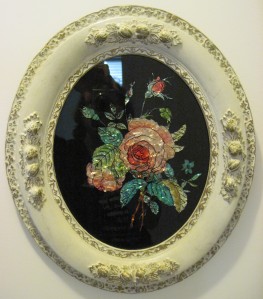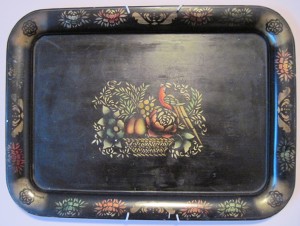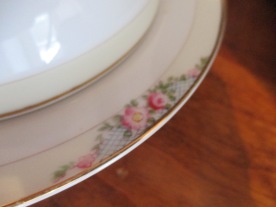Note: This post was inspired by a gentleman recently attending an auction in the Philadelphia area, seeing a beautiful tinsel painting in a group of items that inspired him to bid, and winning the bid. He then saw that on the back of the painting was inscribed in lovely cursive (such as the world will rarely see in the future—I understand kids aren’t taught cursive anymore), “Tinsel painting by Marie Wirth.” I surmise that he then employed a search engine to find out what he could about the artist’s name, whereupon he discovered this website. Various interesting correspondence ensued.
My maternal grandmother, Marie Wirth nee Schneidenbach, daughter of German immigrants who grew up in Newark, New Jersey, born in 1903, was, in addition to a stay-at-home mom, homemaker, great cook, and garden club member, an artist.
In Newark, Marie’s parents owned and operated a restaurant and a boarding house. At times, Marie was pulled out of school to wait tables in the restaurant. I don’t know what the official board of education rules (or child labor rules) were about that, or the following, which suggests that in the early 20th century, high school was optional. At any rate, Marie was evidently not strongly encouraged academically and nudged toward college as I was!
Marie did not complete high school as we know it now in the 21st century. When I queried my mother to clarify the history, she said, “Instead of regular high school, she had taken commercial art lessons.” Through the lessons, she learned the American folk arts of tinsel painting and tole painting, among other types of artwork.
I asked Mom if my recollection was correct that before Marie married, she worked as a commercial artist designing details on women’s lingerie, such as girdles. Mom concurred, saying, “The bit about her working for designing things on women’s girdles is correct.” After she completed the commercial art lessons, said Mom, Marie “then worked at Barclays in Newark where she did the above designing.”
Recollecting her growing-up years during the Great Depression and early WWII in Brooklyn, Mom said, “Grandma didn’t do any artwork except crafts until we were in Bergenfield [New Jersey, where their family moved when mother was in high school in the 1940s] and then later when she was in Pa.” As empty nesters, Grandpa and Grandpa moved to eastern Pennsylvania in the early 1950s.
I can certainly imagine why a 1930s-1940s housewife with three children would have no time to devote to artwork, or any type of “self actualization,” as they call it. First of all the cost of materials would probably have been prohibitive. One Depression-era story handed down was that when times were hard, Marie served a supper of crackers and milk to the family. Also, time would have been a factor—think doing the weekly laundry with a wringer washer. Each summer, the family would get away from the city to a lakeside house in the New Jersey countryside, only, as Mom recollects, while the kids played, swam, and fished, Marie would be slaving over a hot stove canning produce without the benefit of modern kitchen technology. She was probably totally exhausted!
At any rate, once they were living in Bucks County in eastern Pennsylvania in middle age, Marie’s art started to flourish. They lived in a beautiful country home with multiple levels built into a hillside. In the walk-out basement level, Grandma Marie had her art studio set up against a row of windows to the backyard and lovely gardens, which I remember distinctly from my childhood.
Here she created numerous tinsel paintings and tole paintings on metal trays.
My Internet research into tinsel painting suggests that it is an American craft popular in mid-19th century New England, and taught to young ladies. Confirming the New England angle, my mother recollects that the woman who Grandma took lessons from as a young lady was a woman named Natalie who was from Vermont.
Following are a couple examples of her tinsel painting I’m lucky to have in my home.

Tinsel painting of roses

Miniature tinsel painting
A note about the oval frames Marie used for a number of her paintings that I recently learned from corresponding with my aunt: Although Grandpa Fred had a well-equipped wood shop and built furniture as well as restored antique furniture, he “drew the line about making oval frames. He always said he did not have the right equipment for making accurate and beautiful curves. Both he and Mother scoured antique shops, etc. to find them. So I doubt it is his handiwork except for refinishing them.”
I have an example of a metal tray on which she did tole painting as well. Although I now have it hanging on a wall, during my childhood when it belonged to our family, it was at one time used for serving, so has a bit of wear and tear.

Tray with tole painting
Since Grandpa Fred worked on furniture restoration, he and Marie often collaborated on projects. Grandpa restored a number of antique wooden chairs, including crafting new caned or rushed seats. Grandma would then paint such a chair, often with black paint, then stencil and paint a design on the chair back and use gold paint to add detailing around the legs and rungs.
This is one of two such chairs that I have. A relative who knows antiques believes it to be originally made around the 1850s; it was given to me from the estate of Fred’s sister Great Auntie Eleanor and it may have belonged to their grandmother (my great-great-grandmother) Maria Landmann Reutzel.

Circa 1850s chair with stenciling
I think it was actually very exciting and intriguing for our family to learn in the last week that Marie’s artwork caught the eye of a buyer, and also that the buyer was then in turn intrigued enough to research her name and seek to learn more about her artistic career.













